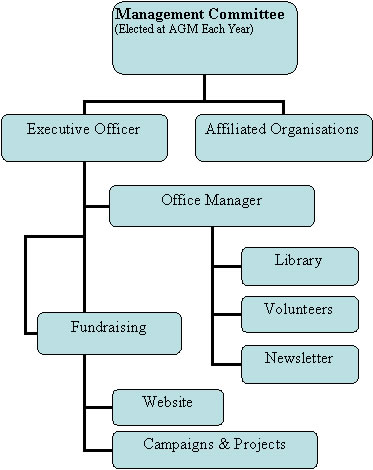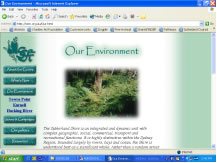Strategy |
|
Our Vision
Our vision is a Sutherland Shire in which community, business and government work in partnership to bring about a sustainable natural environment and a sustainable, productive, and healthy urban society. |
To achieve this, the Centre works to:
- Increase community awareness of the environmental standards needed to underpin a sustainable Shire.
- Encourage increased understanding of the link between environmental health and community health.
- Campaign against activities that will lead to a decline of the Shire’s environmental health.
- Become involved in out-of-region issues that have the potential to affect the Shire’s environment.
|
| The Environment provides the Shire with: |
- Relatively clean waterways and air quality
- Opportunities to enable all generations to experience nature
- Aesthetic charm
- Opportunities for recreation
|
|
The Centre will work in the following ways to achieve these aims:
- Maintain a knowledgeable, reliable and visible presence within the Shire on environmental matters.
- Devise pro-active programs which stress the relevance of the environment for social welfare.
- Develop and maintain resources for use by those who seek environmental information.
- Support councillors, MP’s, individuals and groups who act on the Centre’s goals.
- Partner actively with other organisations and individuals on environmental projects.
|
The Shire’s environment is under constant threat from:
|
- Urban development which:
- Diminishes native vegetation, replacing it with non-indigenous plants and/or hard surfaces
- Fragments native vegetation areas and habitats, thus threatening biological diversity
- Changes or destroys natural drainage areas, and
- Modifies or destroys physical features.
- Poorly managed urban development which places unsustainable strain on the environment, such as sedimentation of waterways, and overuse and abuse of natural areas.
- Lack of resourcing and expertise in the management of the environment, such as in the control of environmentally insensitive urban design, and management of invasive weeds and pest animals.
- Ignorance about the constraints placed on the Shire’s sustainability as a result of activities in areas adjoining the Shire.
|
|
| Top of Page |
Governance
Management of the Sutherland Shire Environment Centre
The Environment Centre, directed by a Management Committee, has minimal paid staff and many volunteers who carry out its varied functions and campaigns. Its organisational structure is summarised in this figure: |
The Management Committee is set up under the Centre’s constitution. Its functions:
- Review the operations of the Centre, determine how its goals should be achieved, and advise the Executive Officer on ways to implement its strategy.
- Oversee the Centre’s finances and advise on how to maintain financial security.
- Oversee the management of affiliated organisations according to their constitutions.
- Appoint the Executive Officer.
Agenda for monthly Management Committee meetings
- Welcome and apologies
- Receive minutes of previous meeting and deal with matters arising
- Report and discussion on progress of the Centre’s programs in light of its aims
- Report and discussion on finances of the Centre
- General business
|
|
 |
Executive Committee
The Executive Committee, comprising the Chair, Executive Officer and Office Manager, reviews progress on the various operations, projects and campaigns of the Centre on a weekly basis. Campaign convenors and program managers are invited to meetings to provide updates.
|
|
| Top of Page |
Direction and Vision
The Centre, recognising that positive change is a slow and subtle process continues to strive for local sustainability from both a local and global perspective. To achieve sustainability, SSEC recognises that a shift in social, economic and political structures is needed. Our community requires stronger links between environmental issues and the social and economic contexts we currently all work within.
To guide SSEC in its decision-making about issues, we have identified a number of tools for change including:
- Socially Critical Thinking – Careful examination and researching of the issues leads us to a better knowledge and understanding of the problems;
- Envisioning – ”Futures Thinking” where do we want our community to be in ten, twenty or fifty years;
- Participation – Community participation is about control in decision making that leads to responsibility and ownership of community decisions, not just consultation; and
- Values – decision making that incorporates cultural, ecological and economic values while including community concerns about equity, social justice, respect, democracy, health, poverty and equality issues.
|
| Top of Page |
Local Environments of Australia Fund (LEAF) |
| Our LEAF campaign (Local Environments of Australia Fund) to promote SSEC as a model in local environmental action has begun again. The Management Committee has approved a fundraising strategy that will be implemented in the coming months. |
 |
For donors LEAF:
- is a unique opportunity to invest in the local environment to promote a productive and sustainable society;
- is a fund to which individuals and organisations can contribute and which disburses grants for local environmental actions;
- promotes local action by the nonprofit community;
- recognises the need for cooperation and collaboration among government agencies, businesses and community members to meet the many challenges and opportunities that are the basis of environmental, social and economic sustainability;
- is a unique fund that advocates philanthropy for the benefit of local community environmental action;
- is a fund that enables individuals and organisations to think globally while acting locally;
- supports Local nonprofit organisations that act to enhance the sustainability and productivity of their local community; and aims:
- to create productive and sustainable communities by supporting programs that recognise the important role of the environment in community wellbeing;
- bring about lasting benefits to the environment and community; work proactively rather than reactively;
- involve a range of stakeholders including citizens of a locality;
- develop and promote local community talents and traditions; and
- strengthen the internal and external practices of local environmental nonprofit organisations.
LEAF is managed by Perpetual Trustees Australia Limited, who ensure that income from the investment of LEAF capital is distributed fairly and with integrity to eligible causes as stipulated by the LEAF grants criteria. |
| Top of Page |
Website |
The Centre’s web site has grown larger and much more complex with each passing year. The Management Committee has approved a radical redesign of the interface and functionality of the site to cope with the increased information load. This redesign will establish a simpler and clearer user interface that is aligned with the Centre's strategic direction. The SSEC website aims to:
- Showcase the local environment;
- Support community-driven campaigns and programs within the shire;
- Be a model local environment centre; and
- Be an effective fundraising vehicle.
|
 |
| Top of Page |
Library
The “R.D. Walshe Environmental Research Library” has continued to grow, offering a valuable source of specialised local and global information on the environment (see library report). |
| Top of Page |
Collaborative Partnerships
Collaborative partnerships is one of the means encouraged by the Centre’s strategy. The intention is to use alliances to improve the sustainability of our community to encourage people from all parts of the community to get together and make a difference. The collaborations are as inclusive as possible with representatives from community, business, government and the media.
The Kai’ Mia Way Trail Project is an example of such a collaborative partnership between community, business and three levels of government. Another such collaboration is currently being explored with the Southern Catchment Management Board. |
| Top of Page |
Community Profile
As an independent not?for?profit association, the Centre is committed to raising community awareness of the need for worldwide ecological sustainability while focusing on the active defence and improvement of the environment of our local bioregions. It is supportive of community, other associations and institutions, business, and government where they are perceived to be acting positively towards the environment.
The Centre continues to achieve positive recognition for its many activities. We are a recognised source of regional expertise on environmental issues. This is evidenced in the committee reports attached. More and more we engage in community-partnering activities such as the Kai’mia Way Project, Botany Bay Planning activities, regional transport strategy, etc. |
| Top of Page |
Financial Sustainability
This past year the SSEC donations decreased from the community by -18% to $130,700 and Grants by over 400% to $142,000. The Centre continues to build a strong and stable fundraising team as an important goal within its strategic plan.
The events committee has successfully achieved their objective of raising funds to help cover the Centre’s office costs such as rates, electricity and telephone bills. Numerous street stalls throughout the Shire took place during the past year.* On behalf of the membership, I sincerely thank the events committee for its commitment and persistence to keep the Centre sustainable.
The Centre continues to move towards longterm financial sustainability as it prepares the strategy to build the Local Environments of Australia Fund (LEAF) to a significant managed fund. We aim to prioritise fundraising in the coming year.
*Just this past week the events committee organised a three day street stall in Sutherland which promises to raise another significant donation to the Centre’s funding needs. |
| Top of Page |
Fundraising Strategy |
The Sutherland Shire Environment Centre has undergone considerable growth in the last four years, expanding its policy work and increasing its administration capacity. The Centre currently has a short-term commitment of core funding for two full-time and one part-time position. This funding commitment expires in 2005. As well the Centre has received various grants which enable it to employ staff and purchase equipment and other resources to undertake specific activities.
In November 2002 the Management Committee identified Fundraising as a key role of the organisation to achieve its aims. By June 2003, they adopted a Fundraising Strategy for the Centre. Our challenge is to develop a secure funding base over the next 2 years. Unless we are able to do so, SSEC could cease to exist in its present form.
The basis of the strategy is to: |
 |
- Increase the Centre’s membership base through active recruitment of members and good management of membership fees.
- Targeted programs for obtaining donations and grant funds.
- Increase donations to the Trust Fund, LEAF, to provide a stable long-term base for organisational sustainability.
- The statement of goals identified five activities the Centre will engage in to achieve its vision:
- Maintain a knowledgeable, reliable and visible presence within the Shire on environmental matters.
- Devise pro-active programs which stress the relevance of the environment for social welfare
- Develop and maintain resources for use by those who seek environmental information
- Support councillors, members of Parliament, individuals and groups who act on Centre’s goals
- Partner actively with other organisations and individuals on environmental projects.
In order to deliver on these activities, the Centre must achieve core funding of $150,000 per year: enabling it to employ two-and-a-half staff members and to cover administrative costs. This funding base delivers only basic support for Centre activities.
In the short term, additional funds are required to:
- Update the website - $20,000
- Employ one or two people to continue with the Trails program - $120,000
- Continue to upgrade library resources - $8,000
- Increase computing facilities for database management, mapping, display and presentations - $7,000
- Promotional material - $15,000
- Capacity Building Activities - $30,000
In the mid term (5 Year), the Centre aims to be able to utilise currently leased premises to establish library and research facilities there, requiring an additional $100,000 to fund mortgage repayments and $75,000 for library staff and resources. In addition, the Centre aims to be able to employ an extra person full time to liaise with the community and undertake campaign work as required (cost $65,000).
In the longer term (ten years), the Centre should aim to have repaid its mortgage and to have built up sufficient funding in the LEAF ($10,000,000) to ensure it of core funding. |
| Top of Page |
Increasing Membership
Our members are the community who share the Centre’s vision, providing it with credibility, and they are one of our resource bases. To date, we have asked little of our members except for an annual membership fee. The Centre and its activities need to become much more visible and people need to be invited to become members. We currently have 100-150 financial members. Our target is 1,000 members by 2007. |
| Top of Page |
Committed Givers Program
The Committed Givers Programs consists of new and current supporters giving an annual donation by making a low ($5 to $20) monthly donation via Direct Debit or Credit Card. The small amount can easily be accommodated into monthly disposable income and any amount above the annual membership fee is tax deductible.
The benefit of this program spreads is that it spread payments over the year in line with income streams rather than a single large payment, it doesn’t need renewal notices and it helps SSEC to better predict income. |
| Top of Page |
Donor and Sponsorship Programs
There are three major strategies under this heading, targeting individuals and organisations to provide donations to the Centre or to LEAF: bequests, supporter appeals, and corporate sponsorship. |
| Top of Page |
Bequests
The Management Committee recognises bequests as an effective way for the community to give to our work. There are three main types of legacy:
Pecuniary is a donation of a specific (named) amount of money. It is simple and straightforward but makes no allowance for inflation.
Residuary is the donation of the remains of an estate once all other costs and liabilities have been dealt with.
Specific is the donation of something of value, which can be used by the Centre appropriately. |
| Top of Page |
Supporter Appeals
This program will use focused and targeted appeals to highlight and promote our key campaigns to generate income for our activities. Major donors often provide one-off donations that offer significant support to programs/projects. |
| Top of Page |
Corporate Sponsorship
SSEC has not worked closely with industry on potential mutually beneficial projects because of the perceived danger of having the organisation’s integrity undermined. SSEC needs to think in a lateral, creative and imaginative way to identify those opportunities where we can attain the support of the corporate sector. |
| Top of Page |
Creating Growth in Programs and Projects
Our objective is to source trust, corporate and government grant funding for existing and new programs/projects outside of SSEC’s core expenditure. |
| Top of Page |
Special Events
Street Stalls have supplied SSEC with a modest, consistent and steady income since incorporation. The success of this fundraising event has been due to the organisation skills of Ruth Zeibots, Pat Elphinston, Ruth Turner and the efforts of many loyal volunteers over the years. These street stalls currently take place six - eight times a year.
Annual Dinners were an effective way of raising funds in the past, but this event lost money to the Centre last year and there is a risk that the Centre could continue lose money on this type of event. Future option will be examined by the Events Committee with recommendations to be presented to the Management Committee.
Raffles (informal) were a traditional form of fundraising for SSEC from 1991 to 2001. Unfortunately, by 2001 the returns on the raffles diminished and the decision was made to discontinue the raffles until a full review was carried out by the events committee.
Chook Raffles and other events. The Events Committee will research other fundraising options such as chook raffles at local pubs etc. and their recommendations to be presented to the Management Committee. |

Events Committee hard at work |
| Top of Page |



